warning INFINITI QX60 2023 Owners Manual
[x] Cancel search | Manufacturer: INFINITI, Model Year: 2023, Model line: QX60, Model: INFINITI QX60 2023Pages: 636, PDF Size: 7.28 MB
Page 498 of 636
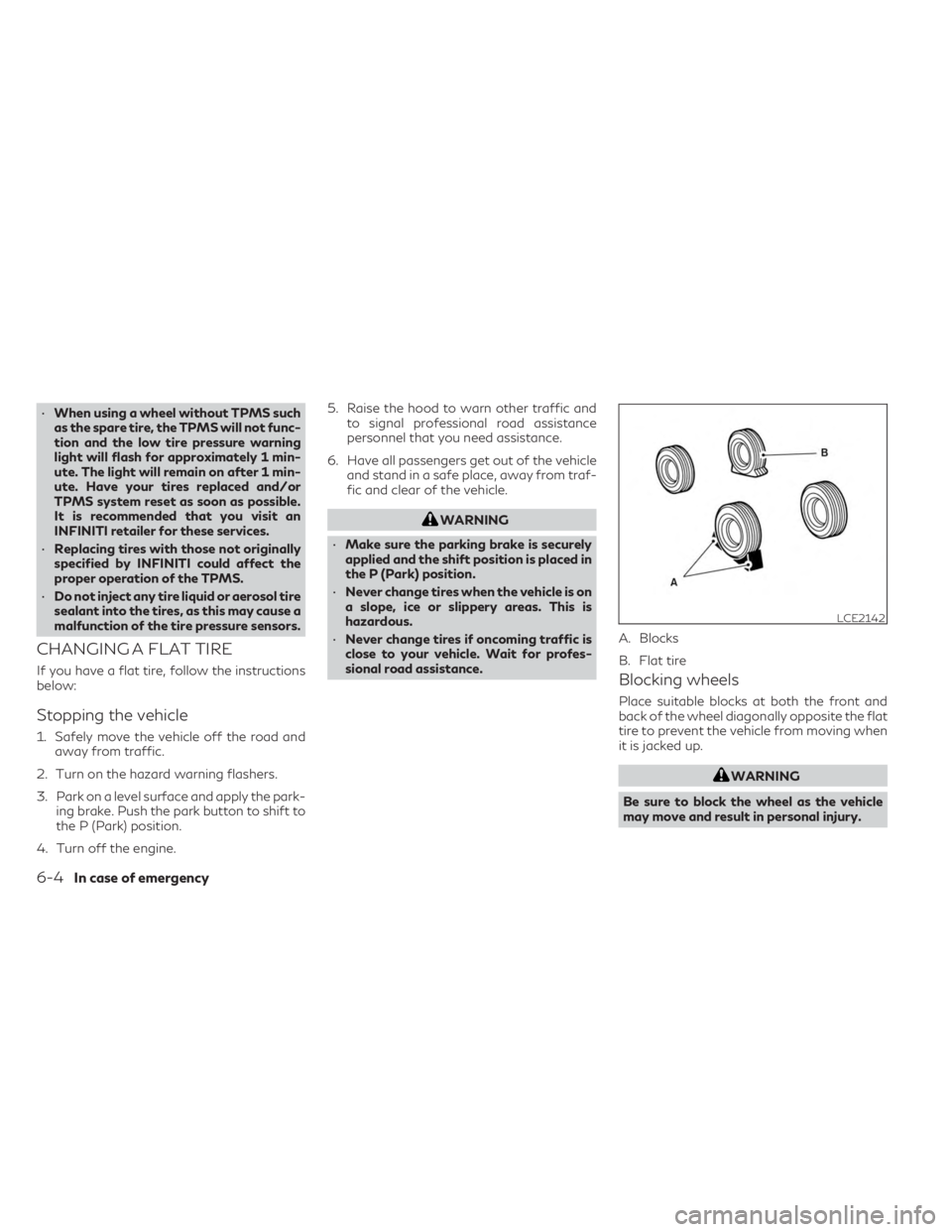
•When using a wheel without TPMS such
as the spare tire, the TPMS will not func-
tion and the low tire pressure warning
light will flash for approximately 1 min-
ute. The light will remain on after 1 min-
ute. Have your tires replaced and/or
TPMS system reset as soon as possible.
It is recommended that you visit an
INFINITI retailer for these services.
• Replacing tires with those not originally
specified by INFINITI could affect the
proper operation of the TPMS.
• Do not inject any tire liquid or aerosol tire
sealant into the tires, as this may cause a
malfunction of the tire pressure sensors.
CHANGING A FLAT TIRE
If you have a flat tire, follow the instructions
below:
Stopping the vehicle
1. Safely move the vehicle off the road and away from traffic.
2. Turn on the hazard warning flashers.
3. Park on a level surface and apply the park- ing brake. Push the park button to shift to
the P (Park) position.
4. Turn off the engine. 5. Raise the hood to warn other traffic and
to signal professional road assistance
personnel that you need assistance.
6. Have all passengers get out of the vehicle and stand in a safe place, away from traf-
fic and clear of the vehicle.
WARNING
• Make sure the parking brake is securely
applied and the shift position is placed in
the P (Park) position.
• Never change tires when the vehicle is on
a slope, ice or slippery areas. This is
hazardous.
• Never change tires if oncoming traffic is
close to your vehicle. Wait for profes-
sional road assistance.
Blocking wheels
Place suitable blocks at both the front and
back of the wheel diagonally opposite the flat
tire to prevent the vehicle from moving when
it is jacked up.
WARNING
Be sure to block the wheel as the vehicle
may move and result in personal injury.
LCE2142
A. Blocks
B. Flat tire
6-4In case of emergency
Page 502 of 636
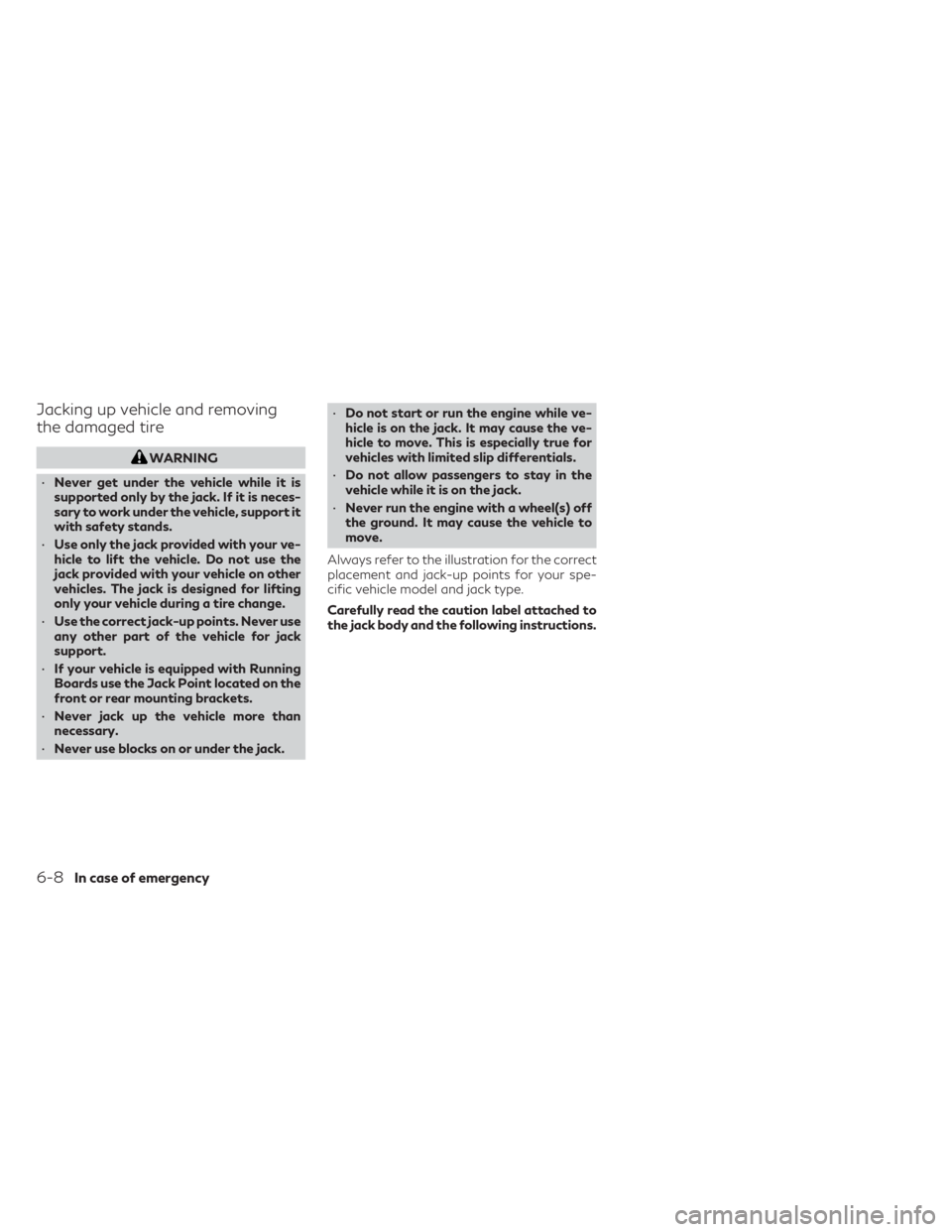
Jacking up vehicle and removing
the damaged tire
WARNING
• Never get under the vehicle while it is
supported only by the jack. If it is neces-
sary to work under the vehicle, support it
with safety stands.
• Use only the jack provided with your ve-
hicle to lift the vehicle. Do not use the
jack provided with your vehicle on other
vehicles. The jack is designed for lifting
only your vehicle during a tire change.
• Use the correct jack-up points. Never use
any other part of the vehicle for jack
support.
• If your vehicle is equipped with Running
Boards use the Jack Point located on the
front or rear mounting brackets.
• Never jack up the vehicle more than
necessary.
• Never use blocks on or under the jack. •
Do not start or run the engine while ve-
hicle is on the jack. It may cause the ve-
hicle to move. This is especially true for
vehicles with limited slip differentials.
• Do not allow passengers to stay in the
vehicle while it is on the jack.
• Never run the engine with a wheel(s) off
the ground. It may cause the vehicle to
move.
Always refer to the illustration for the correct
placement and jack-up points for your spe-
cific vehicle model and jack type.
Carefully read the caution label attached to
the jack body and the following instructions.
6-8In case of emergency
Page 504 of 636

WARNING
• If your vehicle is equipped with Running
Boards use the Jack Point located on the
front or rear mounting brackets.
• The Jack Point is located directly behind
the triangle shaped protrusion near the
front and rear of the Running Board
stepping surface.
1. Loosen each wheel nut one or two turns by turning counterclockwise with the
wheel nut wrench. Do not remove the
wheel nuts until the tire is off the ground.
2. Place the jack directly under the jack-up point as illustrated so the top of the jack
contacts the vehicle at the jack-up point.
The jack-up points are indicated by the
notches under the frame.
If the vehicle is equipped with INFINITI
Running Boards, the jack-up points are
indicated on the running board stepping
surface and the running board mounting
brackets.
The jack should be used on firm and level
ground.
LCE2469
Vehicle shown with running boards
6-10In case of emergency
Page 506 of 636

4. Lower the vehicle slowly until the tiretouches the ground. Then, with the wheel
nut wrench, tighten the wheel nuts se-
curely in the sequence illustrated (
OA,OB,
OC,OD,OE). Lower the vehicle completely.
WARNING
• Incorrect wheel nuts or improperly tight-
ened wheel nuts can cause the wheel to
become loose or come off. This could
cause an accident.
• Do not use oil or grease on the wheel
studs or nuts. This could cause the nuts
to become loose.
• Retighten the wheel nuts when the ve-
hicle has been driven for 621 miles
(1,000 km) (also in cases of a flat tire,
etc.).
As soon as possible, tighten the wheel nuts
to the specified torque with a torque wrench.
Wheel nut tightening torque: 83 ft-lb (113 N·m) The wheel nuts must be kept tightened to
specification at all times. It is recommended
that wheel nuts be tightened to specifica-
tions at each lubrication interval.
Adjust tire pressure to the COLD pressure.
COLD pressure: After vehicle has been
parked for 3 hours or more or driven less
than 1 mile (1.6 km).
COLD tire pressures are shown on the Tire
and Loading Information label affixed to the
driver side center pillar.
5. Securely store the flat tire, tools and jack-
ing equipment in the vehicle.
6. Close the liftgate.
WARNING
• Always make sure that the spare tire and
jacking equipment are properly secured
after use. Such items can become dan-
gerous projectiles in an accident or sud-
den stop.
• The spare tire is designed for emergency
use. For additional information, see
“Wheels and tires” (P. 8-28). To start your engine with a booster battery,
the instructions and precautions below must
be followed.
WARNING
• If done incorrectly, jump starting can
lead to a battery explosion, resulting in
severe injury or death. It could also dam-
age your vehicle.
• Explosive hydrogen gas is always pres-
ent in the vicinity of the battery. Keep all
sparks and flames away from the
battery.
• Do not allow battery fluid to come into
contact with eyes, skin, clothing or
painted surfaces. Battery fluid is a corro-
sive sulfuric acid solution which can
cause severe burns. If the fluid should
come into contact with anything, imme-
diately flush the contacted area with
water.
• Keep battery out of the reach of children.
• The booster battery must be rated at 12
volts. Use of an improperly rated battery
can damage your vehicle.
JUMP STARTING
6-12In case of emergency
Page 507 of 636

•Whenever working on or near a battery,
always wear suitable eye protectors (for
example, goggles or industrial safety
spectacles) and remove rings, metal
bands, or any other jewelry. Do not lean
over the battery when jump starting.
• Do not attempt to jump start a frozen
battery. It could explode and cause seri-
ous injury.
• Your vehicle has an automatic engine
cooling fan. It could come on at any time.
Keep hands and other objects away from
it.
WARNING
Always follow the instructions below. Fail-
ure to do so could result in damage to the
charging system and cause personal injury.
1. If the booster battery is in another vehicle, position the two vehicles to bring their
batteries near each other.
Do not allow the two vehicles to touch.
2. Apply the parking brake. Push the park button to shift to the P (Park) position.
Switch off all unnecessary electrical sys-
tems (lights, heater, air conditioner, etc.). 3. Place the ignition switch to the LOCK or
OFF position.
4. Connect the jumper cables in the se- quence illustrated (
OA,OB,OC,OD).
CAUTION
• Always connect positive (+) to positive
(+) and negative (−) to body ground (for
example, strut mounting bolt, engine lift
bracket, etc.) — not to the battery.
• Make sure the jumper cables do not
touch moving parts in the engine com-
partment and that the cable clamps do
not contact any other metal.
LCE2223
In case of emergency6-13
Page 508 of 636
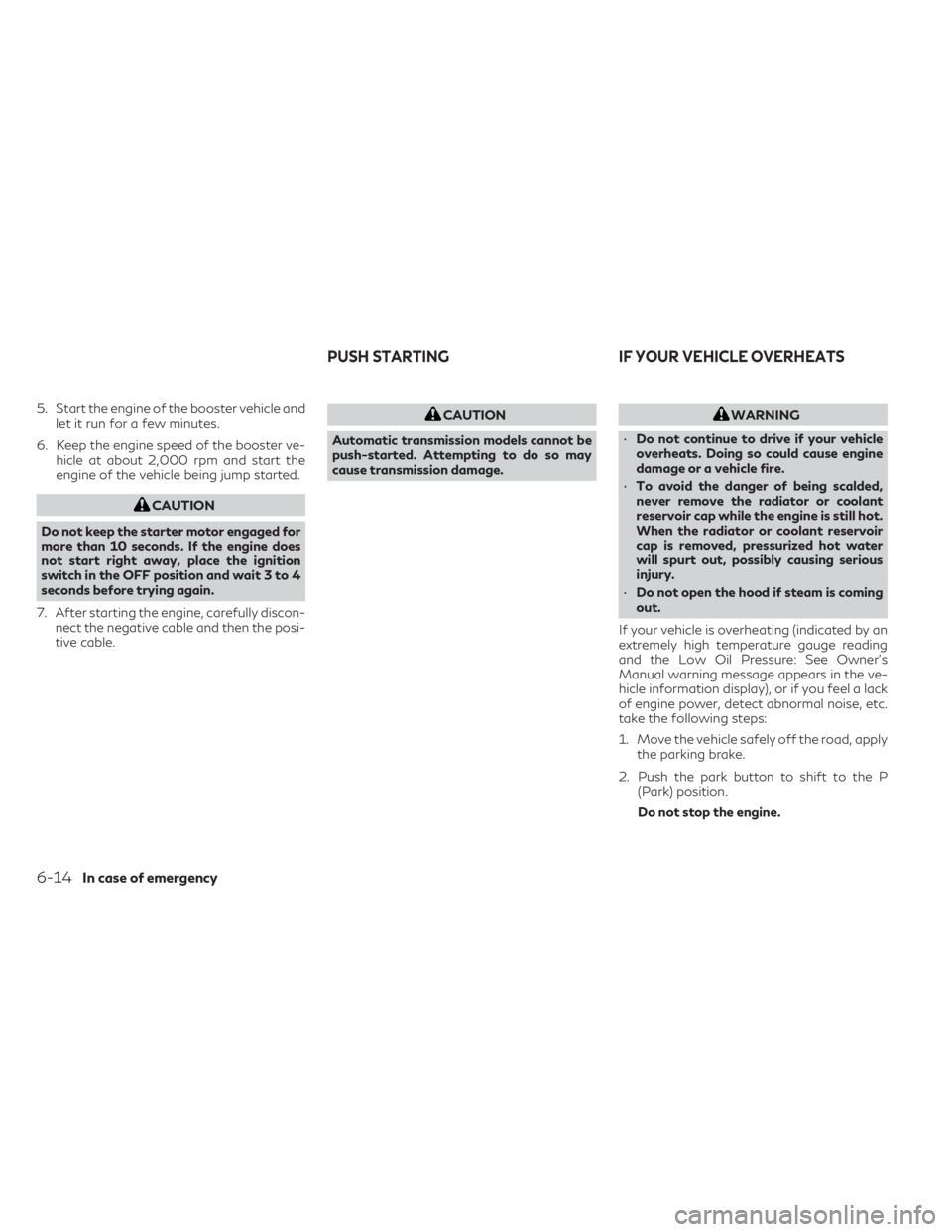
5. Start the engine of the booster vehicle andlet it run for a few minutes.
6. Keep the engine speed of the booster ve- hicle at about 2,000 rpm and start the
engine of the vehicle being jump started.
CAUTION
Do not keep the starter motor engaged for
more than 10 seconds. If the engine does
not start right away, place the ignition
switch in the OFF position and wait 3 to 4
seconds before trying again.
7. After starting the engine, carefully discon- nect the negative cable and then the posi-
tive cable.
CAUTION
Automatic transmission models cannot be
push-started. Attempting to do so may
cause transmission damage.WARNING
• Do not continue to drive if your vehicle
overheats. Doing so could cause engine
damage or a vehicle fire.
• To avoid the danger of being scalded,
never remove the radiator or coolant
reservoir cap while the engine is still hot.
When the radiator or coolant reservoir
cap is removed, pressurized hot water
will spurt out, possibly causing serious
injury.
• Do not open the hood if steam is coming
out.
If your vehicle is overheating (indicated by an
extremely high temperature gauge reading
and the Low Oil Pressure: See Owner’s
Manual warning message appears in the ve-
hicle information display), or if you feel a lack
of engine power, detect abnormal noise, etc.
take the following steps:
1. Move the vehicle safely off the road, apply the parking brake.
2. Push the park button to shift to the P (Park) position.
Do not stop the engine.
PUSH STARTING IF YOUR VEHICLE OVERHEATS
6-14In case of emergency
Page 509 of 636

3. Turn off the air conditioner. Open all thewindows, move the heater or air condi-
tioner temperature control to maximum
hot and fan control to high speed.
4. Get out of the vehicle. Look and listen for steam or coolant escaping from the radia-
tor before opening the hood. If steam or
coolant is escaping, turn off the engine.
Do not open the hood further until no
steam or coolant can be seen.
5. Open the engine hood.
WARNING
If steam or water is coming from the en-
gine, stand clear to prevent getting
burned.
6. Visually check drive belts for damage or looseness. Also check if the cooling fan is
running. The radiator hoses and radiator
should not leak water. If coolant is leaking,
the water pump belt is missing or loose, or
the cooling fan does not run, stop the
engine.
WARNING
Be careful not to allow your hands, hair,
jewelry or clothing to come into contact
with, or get caught in, engine belts or the
engine cooling fan. The engine cooling fan
can start at any time.
7. After the engine cools down, check the coolant level in the engine coolant reser-
voir tank with the engine running. Add
coolant to the engine coolant reservoir
tank if necessary. Have your vehicle re-
paired. It is recommended that you visit an
INFINITI retailer for this service. When towing your vehicle, all jurisdictional
and local regulations for towing must be fol-
lowed. Incorrect towing equipment could
damage your vehicle. Towing instructions are
available from an INFINITI retailer. Local ser-
vice operators are generally familiar with the
applicable laws and procedures for towing.
To assure proper towing and to prevent ac-
cidental damage to your vehicle, INFINITI
recommends having a service operator tow
your vehicle. It is advisable to have the service
operator carefully read the following
precautions:
WARNING
• Never ride in a vehicle that is being
towed.
• Never get under your vehicle after it has
been lifted by a tow truck.
CAUTION
• When towing, make sure that the trans-
mission, axles, steering system and pow-
ertrain are in working condition. Use dol-
lies or flatbed if any of the listed systems
are not working.
• Always attach safety chains before
towing.
TOWING YOUR VEHICLE
In case of emergency6-15
Page 512 of 636
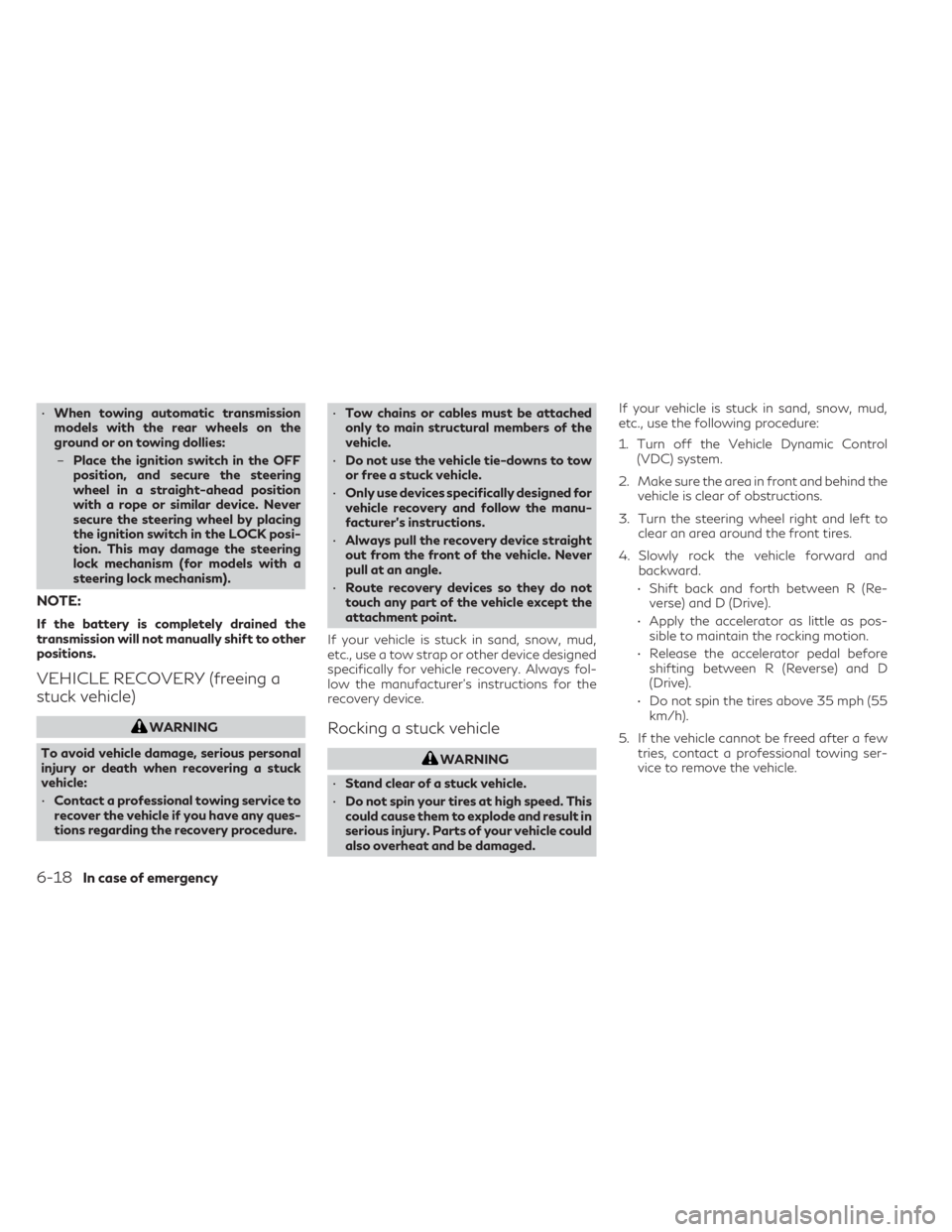
•When towing automatic transmission
models with the rear wheels on the
ground or on towing dollies:
– Place the ignition switch in the OFF
position, and secure the steering
wheel in a straight-ahead position
with a rope or similar device. Never
secure the steering wheel by placing
the ignition switch in the LOCK posi-
tion. This may damage the steering
lock mechanism (for models with a
steering lock mechanism).
NOTE:
If the battery is completely drained the
transmission will not manually shift to other
positions.
VEHICLE RECOVERY (freeing a
stuck vehicle)
WARNING
To avoid vehicle damage, serious personal
injury or death when recovering a stuck
vehicle:
• Contact a professional towing service to
recover the vehicle if you have any ques-
tions regarding the recovery procedure. •
Tow chains or cables must be attached
only to main structural members of the
vehicle.
• Do not use the vehicle tie-downs to tow
or free a stuck vehicle.
• Only use devices specifically designed for
vehicle recovery and follow the manu-
facturer's instructions.
• Always pull the recovery device straight
out from the front of the vehicle. Never
pull at an angle.
• Route recovery devices so they do not
touch any part of the vehicle except the
attachment point.
If your vehicle is stuck in sand, snow, mud,
etc., use a tow strap or other device designed
specifically for vehicle recovery. Always fol-
low the manufacturer's instructions for the
recovery device.Rocking a stuck vehicle
WARNING
• Stand clear of a stuck vehicle.
• Do not spin your tires at high speed. This
could cause them to explode and result in
serious injury. Parts of your vehicle could
also overheat and be damaged. If your vehicle is stuck in sand, snow, mud,
etc., use the following procedure:
1. Turn off the Vehicle Dynamic Control
(VDC) system.
2. Make sure the area in front and behind the vehicle is clear of obstructions.
3. Turn the steering wheel right and left to clear an area around the front tires.
4. Slowly rock the vehicle forward and backward.
• Shift back and forth between R (Re- verse) and D (Drive).
• Apply the accelerator as little as pos- sible to maintain the rocking motion.
• Release the accelerator pedal before shifting between R (Reverse) and D
(Drive).
• Do not spin the tires above 35 mph (55 km/h).
5. If the vehicle cannot be freed after a few tries, contact a professional towing ser-
vice to remove the vehicle.
6-18In case of emergency
Page 516 of 636
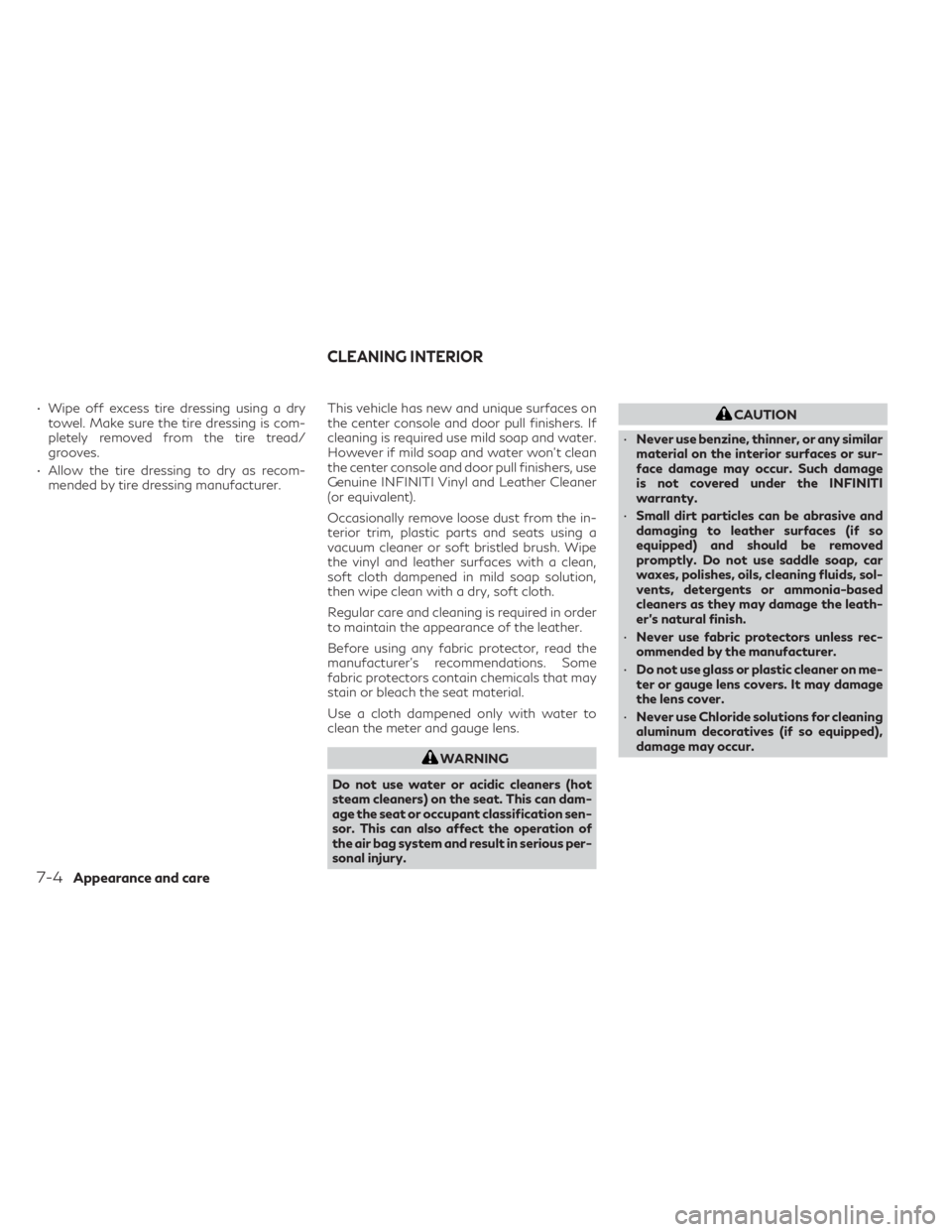
• Wipe off excess tire dressing using a drytowel. Make sure the tire dressing is com-
pletely removed from the tire tread/
grooves.
• Allow the tire dressing to dry as recom- mended by tire dressing manufacturer. This vehicle has new and unique surfaces on
the center console and door pull finishers. If
cleaning is required use mild soap and water.
However if mild soap and water won’t clean
the center console and door pull finishers, use
Genuine INFINITI Vinyl and Leather Cleaner
(or equivalent).
Occasionally remove loose dust from the in-
terior trim, plastic parts and seats using a
vacuum cleaner or soft bristled brush. Wipe
the vinyl and leather surfaces with a clean,
soft cloth dampened in mild soap solution,
then wipe clean with a dry, soft cloth.
Regular care and cleaning is required in order
to maintain the appearance of the leather.
Before using any fabric protector, read the
manufacturer's recommendations. Some
fabric protectors contain chemicals that may
stain or bleach the seat material.
Use a cloth dampened only with water to
clean the meter and gauge lens.
WARNING
Do not use water or acidic cleaners (hot
steam cleaners) on the seat. This can dam-
age the seat or occupant classification sen-
sor. This can also affect the operation of
the air bag system and result in serious per-
sonal injury.
CAUTION
• Never use benzine, thinner, or any similar
material on the interior surfaces or sur-
face damage may occur. Such damage
is not covered under the INFINITI
warranty.
• Small dirt particles can be abrasive and
damaging to leather surfaces (if so
equipped) and should be removed
promptly. Do not use saddle soap, car
waxes, polishes, oils, cleaning fluids, sol-
vents, detergents or ammonia-based
cleaners as they may damage the leath-
er’s natural finish.
• Never use fabric protectors unless rec-
ommended by the manufacturer.
• Do not use glass or plastic cleaner on me-
ter or gauge lens covers. It may damage
the lens cover.
• Never use Chloride solutions for cleaning
aluminum decoratives (if so equipped),
damage may occur.
CLEANING INTERIOR
7-4Appearance and care
Page 517 of 636
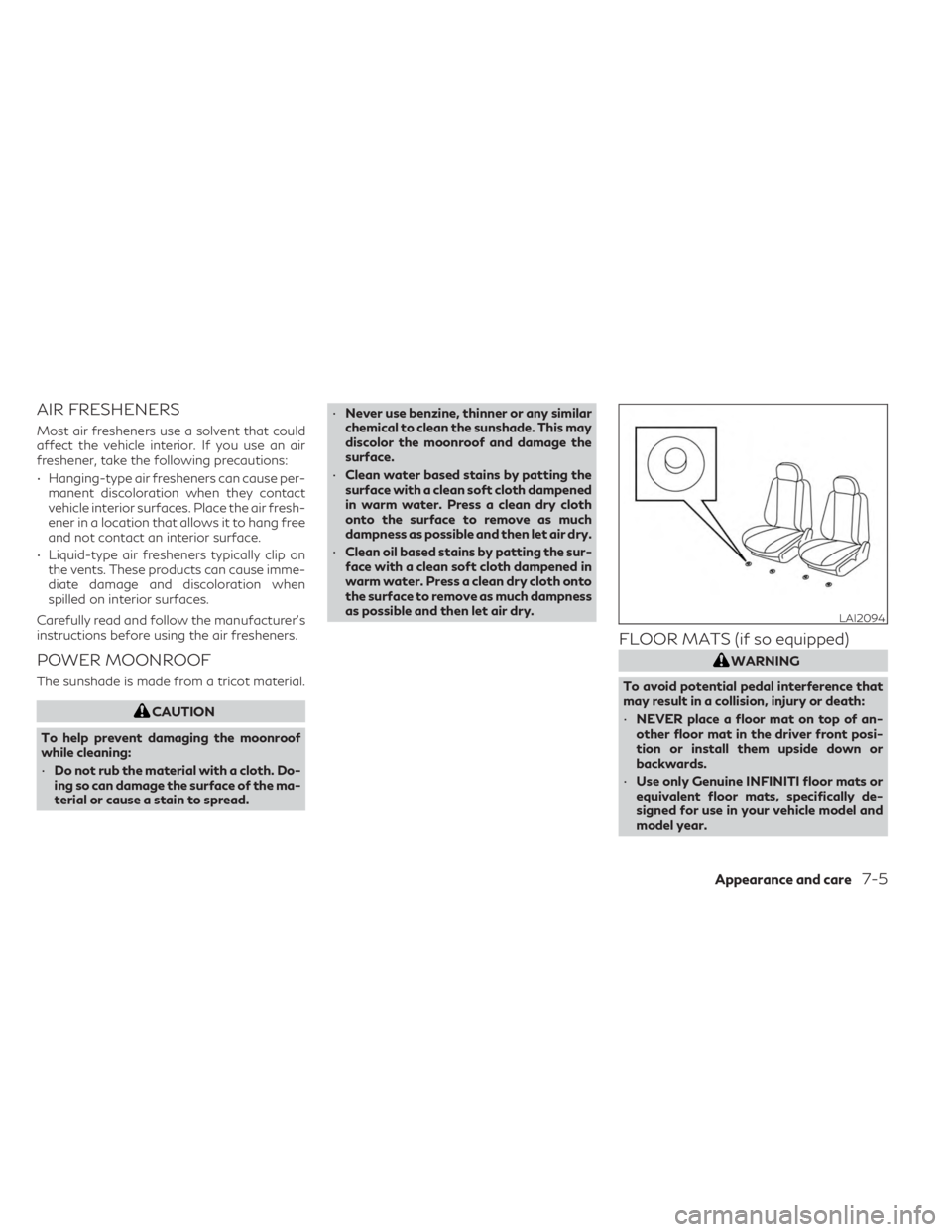
AIR FRESHENERS
Most air fresheners use a solvent that could
affect the vehicle interior. If you use an air
freshener, take the following precautions:
• Hanging-type air fresheners can cause per-manent discoloration when they contact
vehicle interior surfaces. Place the air fresh-
ener in a location that allows it to hang free
and not contact an interior surface.
• Liquid-type air fresheners typically clip on the vents. These products can cause imme-
diate damage and discoloration when
spilled on interior surfaces.
Carefully read and follow the manufacturer's
instructions before using the air fresheners.
POWER MOONROOF
The sunshade is made from a tricot material.
CAUTION
To help prevent damaging the moonroof
while cleaning:
• Do not rub the material with a cloth. Do-
ing so can damage the surface of the ma-
terial or cause a stain to spread. •
Never use benzine, thinner or any similar
chemical to clean the sunshade. This may
discolor the moonroof and damage the
surface.
• Clean water based stains by patting the
surface with a clean soft cloth dampened
in warm water. Press a clean dry cloth
onto the surface to remove as much
dampness as possible and then let air dry.
• Clean oil based stains by patting the sur-
face with a clean soft cloth dampened in
warm water. Press a clean dry cloth onto
the surface to remove as much dampness
as possible and then let air dry.
FLOOR MATS (if so equipped)
WARNING
To avoid potential pedal interference that
may result in a collision, injury or death:
• NEVER place a floor mat on top of an-
other floor mat in the driver front posi-
tion or install them upside down or
backwards.
• Use only Genuine INFINITI floor mats or
equivalent floor mats, specifically de-
signed for use in your vehicle model and
model year.
LAI2094
Appearance and care7-5